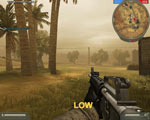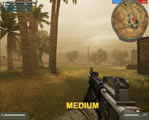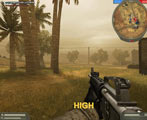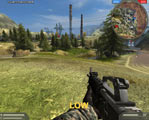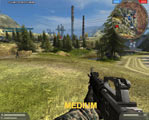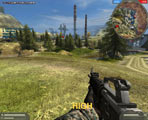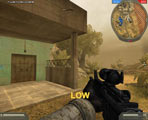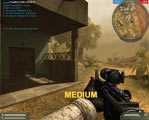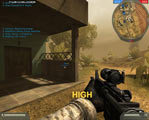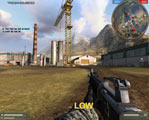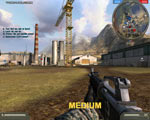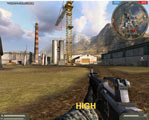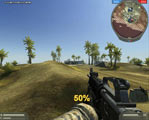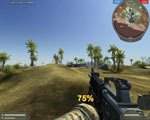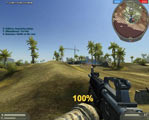Battlefield 2 Tweak Guide
[Page 5] In-Game Settings
In this section I provide full descriptions for Battlefield 2's in-game settings, and where possible I provide general recommendations. I note the performance impact of each setting, although bear in mind that it is impossible for me to give exact performance impacts - it all depends on your specific hardware combination and your other game and system-wide settings.
Player Accounts
Before you can access the in-game settings or play the game you will need to login to an account first. There are two types of accounts - Singleplayer (Offline) and Multiplayer (Online):
Online Account: You must have a valid online account and an active Internet connection if you want to play BF2 multiplayer. You can use an existing GameSpy account if you remember the details. If you want to create a new account, you will have to enter a unique Username, a Password and a unique Email address which is not already being used by you or anyone else for another account. If you want to load up an existing online account, you can retrieve its details simply by entering the Username and Password, or the appropriate Email address, then clicking the 'Retrieve Account' button. In fact if you find you are having difficulties finalizing the creation of a new account, simply exit the game, restart it and try to retrieve the account with the appropriate details.
Your online account is very important - do not provide its details to anyone else. While your online account is not directly tied to your CD Key - the serial number you entered when installing BF2 - your account and/or your CD key can be banned for cheating which prevents you from using your current copy of BF2 to play online on certain servers, regardless of the account you use.
Whenever you start BF2, login to your online account to play BF2 Multiplayer. Your main account details will be displayed on the login screen, and the password box will automatically be filled with the correct password if the 'Remember Password' box is ticked. If you think this is risky in your current environment, untick the box. Note that if you pressed any keys prior to seeing the Login screen, these may be added into your password box, and hence when you click the Login button it will result in an error: refrain from pressing any keys during loadup and/or use the No Intro Movies tweak at the end of this guide. If in doubt clear the Password box and retype your original password.
Update: As of the 1.03 patch, you will see a news box whenever you login. You can click the Close button to skip the latest BF2 news. If you click Open, BF2 will close and the news item will open in a new browser window. I haven't found any way to prevent it coming up in the first place.
Update 2: To automatically login to BF2 whenever you launch the game, see the Conclusion section of this guide for an advanced tweak using the command line parameters.
Offline Account: If you want to play singleplayer Battlefield 2 without connecting to the Internet, you must first create an offline account. To do this, click the 'Manage Accounts' button on the main Account Login screen. Next, click the Singleplayer tab at the top right, and enter whatever username you wish to use for Singleplayer - it doesn't matter if it's not unique. Once created, this account will be added to your main Account Login screen, and you can highlight it and click 'Select Account' whenever you want to play BF2 Singleplayer offline.
Note that you can also play Singleplayer using your online account, however you must remain connected to the Internet and logged in to use your online account for singleplayer mode, whereas using an offline account allows you to disconnect from the Internet and still play BF2.
Note further that each of your accounts (both Single and Multiplayer) have different settings attached to them, including separate video, audio and control settings. To learn more about where these profiles are saved see the Advanced Tweaking section. For ease of use I recommend having only one Online account, and using that for both single and multiplayer.
In-Game Settings
Once you've logged in with your selected BF2 account, on the main menu screen click the Options button and you will find the following in-game setting options, which are each explained in detail below:
Game Options
Opt Out of Voting: From time to time other players will initiate votes for various reasons, such as a mutiny against the current Commander or a map change. If you want to exclude yourself from having to constantly vote in these, select this option. Obviously this means you will have no input into decisions such as map changes, changes in Commander, etc.
Quit Confirm Dialog Disable: If ticked, this option will get rid of the confirmation boxes which appears whenever you click try to exit a game, or press the Quit button to exit BF2. This is useful if you just don't want to go through an extra mouse click to quit/exit. Alternatively if you don't want to quit by clicking the wrong button by accident leave this enabled.
Reverse Mousewheel Selection: If ticked, rolling the scroll wheel on your mouse upwards will mean that your selection action will scroll down a list. Set to taste, has no performance impact.
Auto Reload: If ticked, whenever your weapon runs empty you will automatically reload another clip/grenade/missile. This is recommended, as otherwise you will manually have to press your Reload button and this can take an extra split second which may be critical. Note some weapons on vehicles have a fixed reload time, and automatically reload after that period regardless of this setting.
Auto Ready: If ticked, you will always automatically be ready to begin playing at the start of a round. On servers where all players have to indicate they are ready before a game begins, having this option unticked could result in delays, so keep it ticked. Most servers don't need or use Auto Ready as there is no pre-round wait.
Minimap: The minimap is the small map at the top right of the in-game screen. You can set it to rotate as your viewpoint changes (Map Rotation Follows Player), or be unmoving (Static) by selecting one of these options. There is no practical impact on performance, select one to suit your taste.
Connection Settings: Battlefield 2 requires a broadband connection and cannot be played on a dialup modem. As such the options for connection speeds here are limited to 'Cable 256 KBPS or Better', or 'T1 (LAN)'. For all broadband users playing on the Internet I strongly suggest selecting the first option, as the T1 (LAN) option requires too much bandwidth to maintain steady pings - clearly it is designed for LAN play. To check your Ping in an online game, press the TAB key (default) and look at the number to the far right of your name. For more details on Pings and Lag, see the Video settings below, as well as the Server Browser section later in the guide.
HUD Settings: Here you can use the sliders to adjust various aspects of your Heads Up Display (HUD). To change the color of your Crosshair, use the Red, Green and Blue sliders under 'Crosshair Color' - check the crosshair displayed in the small preview graphic on this page to see the impact of your changes. You can also adjust the Transparency (how see-through items are) for the various HUD items, the Minimap, the Icons on the minimap, and the Crosshair itself. For the most part the defaults are best, however you may wish to change them to suit you particular needs.
Controls
This section contains the key/mouse/joystick mappings for all infantry and vehicle movements. Make absolutely certain you go through the five sub-screens of the Controls section carefully. The 'Common Controls' section contains your main controls. Pay particular attention to the 'Mouse Settings' options under each control sub-section - adjusting these to the correct values is vital in particular for successfully controlling vehicles.
Mouse Settings: The 'Invert Mouse' option if ticked means that pushing your mouse forward will move the character's viewpoint downwards, pulling it back will move the view upwards. If unticked it is the opposite - set to suit your preferences. The Sensitivity setting controls how sensitive your in-game movements are to your mouse movements. The 'Yaw Factor' setting controls the degree to which vehicles roll left or right, while the 'Pitch Factor' controls the degree to which they tilt forward or back - the higher the factor, the more sensitive vehicles will be to such movements.
Don't forget to click the Apply button at the bottom of every control sub-screen each time you change controls on that particular screen. This saves your settings, and forgetting to do this will lose your changes as you move to another screen. If you don't want to save your changes, click the Cancel button instead, and if you mess up your mappings click the 'Reset to Default' button to revert them all back to the original settings.
Note that if you have any problems using a particular control device such as a joystick or gamepad, make sure you have installed the device's drivers correctly, and also keep in mind that BF2 doesn't support every gaming controller available. Read the Readme.txt file which comes with BF2 for details of particular control issues, and see the Advanced Tweaking section for more details of how to edit the control configuration file to overcome some of these problems.
Video
Battlefield 2's performance (particularly when online) is highly dependent on your graphics card and video settings, much more so than your CPU speed. Pay particular attention to the descriptions below if you want a good balance of performance and image quality, and of course if you run a graphics card which is old, slow or unsupported by BF2, keep this in mind if your performance is still poor at any setting.
Display Mode: This setting controls the resolution of Battlefield 2. It displays the number of horizontal pixels by vertical pixels and the particular Refresh Rate the screen will run at. The greater the number of pixels, the clearer the game's image appears but the more work your graphics card has to do to render (draw) all of it. Make sure you choose a display mode with the highest refresh rate listed - the refresh rate is the number after the @ sign, and the higher the number the more times per second the screen can 'refresh' (redraw itself), meaning less eye strain. If you can't find the resolution you want here, first choose the one closest to it (at the highest refresh rate), then see the Advanced Tweaking section for details of how to set a custom resolution.
Update 1: As of the 1.03 Patch, 1280x1024 has been added as a standard resolution on the Display Mode list, so you don't need to use the command line method to force this resolution anymore.
Update 2: Widescreen users can now try Widescreenfixer to force proper widescreen support in BF2.
Update 3: Proper Widescreen support has been added as of the 1.50 Patch - see Page 4 for details.
Overall Quality: This setting allows you to choose a pre-defined video settings level, however it is definitely not recommended that you use this method: make sure it's set to Custom then manually adjust the various elements of your video settings as covered below:
Terrain: This setting controls how rich the details on the terrain are. The available options here are Low, Medium and High - see the screenshot comparison below for differences. Note that at each higher level of terrain setting, there are more visible features in the terrain, such as more grass, different types of foliage, more sand, pebbles and so forth. However this comes at the cost of a noticeable decrease in your performance, especially at the High level. The image quality difference between Low and Medium is pronounced, while that of Medium to High is not so noticeable.
Effects: This setting controls various special effects in the game. The difference between Medium and High is not noticeable, but when set to Low the most significant impact is that decals such as bullet holes will no longer appear on walls and objects. However even at Low the explosions, smoke and puffs of dust from bullet impacts will still appear in full detail. The effects setting does not have a major impact on overall performance, however if you are slowing down significantly during heavy combat scenes reduce it to Low to improve FPS. Note that you cannot disable the 'blurred vision' effect which occurs when you are near an explosion - that is a part of the game regardless of your settings, and to disable it (even if possible) would be considered a cheat.
Geometry: The Geometry setting controls the Level of Detail (LOD) setting for various objects and landscape in the game. The options are Low, Medium and High and for most intents and purposes there is virtually no difference between the three levels. At higher levels certain objects will appear more detailed, such as rounder boulders and more curved landscape (i.e. more polygons visible). More importantly, at the higher levels vehicles will come into view sooner when far away, as more of their details are shown earlier. Obviously performance is better at the lowest level, but the extent of it depends on your system. For the reason that it may help you detect vehicles sooner, you should keep this at High unless your system is really struggling.
Texture: Textures are the 2 dimensional surfaces of every 3D object in the game. The higher this setting, the better these surfaces appear, with more detail and realism. However at higher settings more Video RAM is required to hold all of them for rapid access by the game. Thus on systems with only 128MB of Video RAM or less and/or slow hard drives I recommend using Medium or even Low to ensure smoother gameplay. The High setting will improve image quality slightly over the Medium setting, but will contribute greatly to frequent loading pauses and generally reduce performance in the game. The image quality difference is shown in the screenshot comparison below - as can be seen, the textures in BF2 are not fantastic even at the highest setting. The difference between Low and Medium is most noticeable in the blurring of the landscape and the player's clothing at Low. At Medium this sharpens up noticeably, and at High there is only a slight improvement over Medium. For those with very low system memory, Medium is recommended, but for most people High is fine.
Lighting: This setting controls the lightmaps used for static objects in the game, such as building. The screenshot comparison below shows the difference - pay particular attention to the shadow of the building. The difference between High and Medium is negligible, while Medium to Low results in the complete removal of the fixed shadows for the building. This is far less realistic, and for that reason I recommend Medium Lighting. High is not necessary in many cases and can contribute to loading pauses on modest systems.
Dynamic Shadows: This setting controls the shadows cast by moving objects. These 'dynamic' shadows can be switched Off, or set to Low, Medium or High. Each higher level of dynamic shadows means slightly more detailed shadows are cast, particularly for the shadows cast by players and vehicles. However this setting has a dramatic impact on performance, particularly when there are multiple sources of light. Setting this to High or even Medium will result in a great deal of lag/jerkiness during gameplay, and in particular during heavy combat scenes. If your system is old or relatively weak, I strongly recommend Medium or Low, although setting this to Off removes all shadows and thus noticeably reduces realism, so Off is not recommended.
Dynamic Light: This setting relates to lighting from muzzle flashes, fire, explosions, missiles etc. The available options are Off, Low, Medium and High. Quite obviously turning these lights Off reduces realism significantly, but improves performance noticeably. Dynamic lights interact with objects to cast shadows (See Dynamic Shadows setting above), and as such the impact of this setting also depends on your settings for Dynamic Shadows. For old systems I recommend Medium or lower for this setting, as a setting of High can contribute greatly to pauses, lag and jerkiness in the game.
Antialiasing: The options here are Off, 2x, 4x and 8x. When enabled, Antialiasing (AA) smooths the appearance of jagged lines, something which BF2 has plenty of. The higher the level of Antialiasing (i.e. 2x, 4x, etc.), the greater the negative performance impact in return for better image quality. For more details and examples see this page of my Gamer's Graphics & Display Settings Guide. Using Antialiasing correctly is covered in the Troubleshooting Tips section, but basically it involves disabling any forced Antialiasing in your graphics card's control panel, and then selecting it here if you want to enable it. Given its age, the use of Antialiasing can really help BF2 look much better on newer systems with only a mild performance hit on recent systems. For older systems, it is recommended that AA be left Off.
Texture Filtering: This setting controls how crisp and clear textures look as they fade into the distance. The available options are Low, Medium and High, and the higher the setting the better the image quality in return for a decline in performance. The screenshot comparison below shows the impact of different levels of filtering - note in particular the different levels of the blurring on the dirt road leading off into the distance. The texture filtering settings at Medium and High should correspond with 2x Anisotropic Filtering (AF) and 4xAF respectively, with Low being Trilinear. For more details, again refer to the bottom of this page of my Gamer's Graphics & Display Settings Guide. For most people the Medium setting should be optimal for performance purposes while still maintaining good image quality; High on newer systems can really help BF2 look much more acceptable.
View Distance Scale: This slider determines the amount of visible detail your character can see in the distance. The screenshot comparison below shows the differences at 50% (the minimum), 75% and 100% (the maximum) View Distance settings. Note the crane in the distance becomes invisible at 75% view distance. While reducing the view distance improves performance due to less scenery being rendered, it is strongly recommended that you do not reduce your view distance below 100%. A reduced view distance can place you at a disadvantage in the game against other players who use 100% view distance, making it harder for you to spot distant players and vehicles. Keep this setting at its maximum and reduce other settings first to improve your performance if more FPS is necessary.
To implement the changes you've made here, be sure to click the Apply button at the bottom of the screen. As the warning dialog tells you, your shaders may need to be optimized each time you change settings - particularly when you choose settings which you haven't used in the past. See the Clearing Shader Optimizations tip under the Troubleshooting Tips section of this guide for more details of shader optimizations.
The next page continues the descriptions of the in-game settings.

